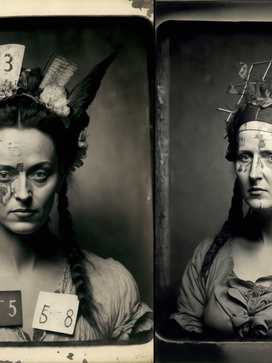True Fiction
The Enigmatic Work of Amara Petrov
As a storyteller, weaving narratives has been my craft since my journey began as a photographer. Whether through the pages of my novels or the frames of my photography, I've always
sought to captivate and transport.
The work detailing the life and times of Amara Petrov is entirely fictional, born from my fascination with the advent of Stable Diffusion. Through the use of my photographs and the training of various models to mimic my style, I've constructed her world with seamless cohesion.
The prospect of journeying back in time - in this case, Europe early 20th century - with a technology still a century away captivates me. In crafting this narrative, I've embarked on a form of time travel, bringing forth places and characters that never existed, yet find themselves vividly portrayed on the page.
It embodies a fascinating paradox.

Amara Petrov
1918-1991
Until recently, the captivating work of Ararma Petrov remained hidden from the public eye, safeguarded by her estate. After persistent efforts and numerous meetings with the estate's executor, I managed to gain her trust. With her approval, the archives were opened, revealing a treasure trove of masterpieces waiting to be unveiled to the world.
This exhibition showcases a series of photographs captured by Ararma Petrov during her tenure as the production designer and artistic director of CIRKISS. Established in 1940, CIRKISS was more than just a traditional circus; it was a subversive collective of clowns who dared to challenge societal norms and conventions.
Performing in what was once the former Soviet Union, CIRKISS operated under constant scrutiny and harassment by the secret police. The oppressive regime was notorious for its ruthless tactics aimed at suppressing any form of rebellion or dissent.
In 1944, the shadow of oppression descended upon CIRKISS as the secret police launched a crackdown, resulting in the arrest of the entire cast and crew. This dark chapter in history, now known as the Great Clown Purge, saw Amara and her fellow performers subjected to unimaginable persecution and injustice. The Great Clown Purge cast a long shadow over the circus community, leaving scars that would never fully heal.
Upon her release from captivity in 1947, Amara embarked on a journey of renewal and rediscovery, seeking solace and inspiration in vibrant post war Paris. Despite the scars of her past and the weight of her harrowing experiences, she refused to be defined by the horrors she had endured. Instead, she channeled her pain and resilience into her art, using her camera as a means of catharsis and self-expression.
Despite the somber themes that pervade her photographs, in this second body of work, there is a delicate beauty and resilience evident, captured in the fleeting moments of grace and vulnerability that she immortalized through her lens. Amara found inspiration in the children of her neighborhood, drawing from their innocence and curiosity as a beacon of hope amidst the darkness that threatened to engulf her. Through her interactions with them, she discovered a renewed sense of purpose and connection, forging bonds that transcended language and culture.
Amara Petrov died in the arms of her life partner Gabriel Meyer, on October 12, 1991 at the age of 73.
A heartfelt thank you to Rosemarie Meyer, executor of the Amara Petrov state, whose trust made this exhibit possible. Her unwavering support and belief in preserving Amara's legacy have brought these treasures to light for all to appreciate.
True Fiction
The Enigmatic Work of Amara Petrov
The Clown Purge 1944
In 1944, the shadow of oppression descended upon CIRKISS as the secret police launched a crackdown, resulting in the arrest of the entire cast and crew. This dark chapter in history, now known as the Great Clown Purge, saw Amara and her fellow performers subjected to unimaginable persecution and injustice. The Great Clown Purge cast a long shadow over the circus community, leaving scars that would never fully heal.
_JPG.jpg)

One of just two surviving headpieces crafted by Amara Petrov is the one created for the 1942 production 'Kahepalgelise Pilguga' (Duplicity's Gaze), worn by Marina Kask.
Courtesy of the Amara Petrov Estate.

Amara Petrov’s Interrogation Report.
01-08-1943
“The interrogation began immediately after the suspects capture. The subject showed serious defiance by refusing to divulge any information. Used aggressive tactics to elicit cooperation with limited success. Persistence is necessary to extract fragmented intelligence indicating potential accomplices and targets. Further investigation justified the dismantling of the anarchist network. The suspect was remanded in custody for further questioning and analysis.”
Amara was arrested 4 times in the span of two years. The last was in December 5th 1944. She was sentenced to three years for “crime against society.”
On loan from the The Royal Circus Academy
Prit Saar Interrogation Report
01-08-1943
“The interrogation of the suspected anarchist began immediately after the capture. The subject showed serious defiance by refusing to divulge any information. Used aggressive tactics to elicit cooperation with limited success. Persistence is necessary fragmented to extract intelligence pointing to potential accomplices and targets. Further investigation justified the dismantling of the anarchist network. The suspect was remanded in custody for further questioning and analysis.”
Notice the striking resemblance between the reports.Such striking similarities were a recurring motif in these proceedings, suggesting a pattern of contrived accusations and manufactured narratives."
On loan from the The Royal Circus Academy
Secret Police Notebook
Discovered in 1974, this fascinating notebook provides a chilling glimpse into the operations of the secret police as they meticulously tracked members of Cirkiss. Within its pages are over two hundred photographs, documenting individuals under surveillance. Created from early 1943 until the mass arrests in December of 1944, this artifact serves as a haunting reminder of the surveillance tactics employed during that tumultuous period.
On loan from the The Royal Circus Academy
















































